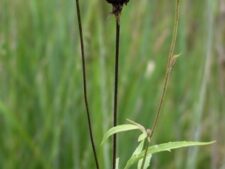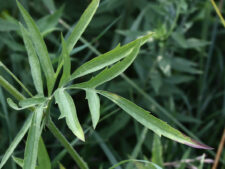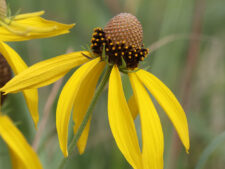
GRAY-HEADED CONEFLOWER
Ratibida pinnata
SUNFLOWER FAMILY (Asteraceae)
 Identification
Identification
- Flowering time - July, August
- Common in prairies at Neale Woods
- Round or oval central disk with drooping yellow ray florets
- Deeply divided leaves
- See comments for comparison with other yellow composites
This native perennial grows up to 4 feet tall. The alternate leaves are usually divided into 1-4 pairs of opposite leaflets with another at the tip (D). Flower heads on long stalks have globe to egg-shaped oval central disks surrounded by 6-13 yellow, drooping ray florets up to 2 inches long (A,B). Disk color changes from pale green or gray to brown as the disk florets mature (B). Only the disk florets (E) are fertile, producing many small brown seeds (C) with an anise scent.
Grows in moist to dry prairies, often on ground with some disturbance. It flowers in July and August. Common in prairie restorations at Neale Woods.
This plant is the “eggheaded relative” of the “coneheads” or Rudbeckias. Look for the combination of deeply divided leaves, oval to round central disk and drooping ray flowers. The Rudbeckias, Black-Eyed Susan (Rudbeckia hirta), Sweet Coneflower (Rudbeckia subtomentosa) and Brown-Eyed Susan (Rudbeckia triloba) have cone-shaped disks and spreading ray flowers. Golden Glow (Rudbeckia laciniata) also has drooping ray flowers and deeply cut lower leaves, but is taller, likes shady moist sites, and has a green disk.
When crushed the aromatic seed heads give off an anise-like scent.
The content of NatureSearch is provided by dedicated volunteer Naturalists of Fontenelle Forest who strive to provide the most accurate information available. Contributors of the images retain their copyrights. The point of contact for this page is: Neal Ratzlaff.




